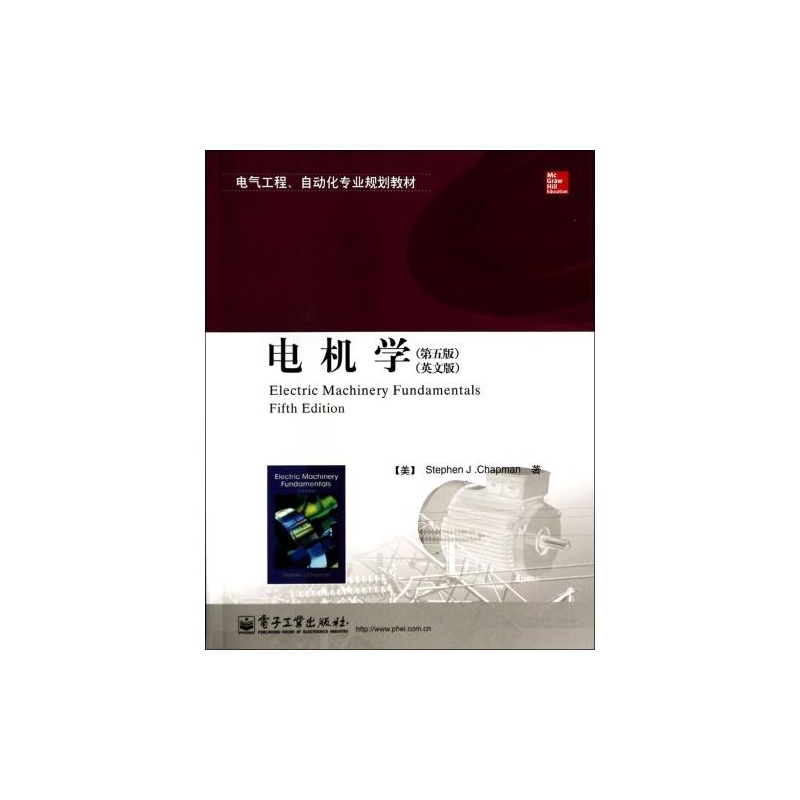 [内容简介]
[内容简介]
本书是关于电机学的经典教材。全书内容涉及电机原理、变压器、交流电机、同步发电机、同步电动机、感应电动机、直流电机、直流电动机和发电机、单相及特种电动机等,附录内容包括三相电路、线圈节距及分布绕组、同步电机的凸极理论、常数及转换系数表。全书叙述清晰,图文并茂,例题、习题丰富,并结合MATLAB进行了大量的仿真分析。
[目录]
TABLE OF CONTENTS
Chapter 1 Introduction to Machinery Principles
1.1 Electrical Machines, Transformers, and Daily Life
1.2 A Note on Units and Notation
1.3 Rotational Motion, Newton’s Law, and Power Relationships
1.4 The Magnetic Field
1.5 Faraday’s Law—Induced Voltage from a Time-Changing Magnetic Field
1.6 Production of Induced Force on a Wire
1.7 Induced Voltage on a Conductor Moving in a Magnetic Field
1.8 The Linear DC Machine—A Simple Example
1.9 Real, Reactive, and Apparent Power in Single-phase AC Circuits
1.10 Summary
Questions
Problems
References
Chapter 2 Transformers
2.1 Why Transformers are Important to Modern Life
2.2 Types and Construction of Transformers
2.3 The Ideal Transformer
2.4 Theory of Operation of Real Single-Phase Transformers
2.5 The Equivalent Circuit of a Transformer
2.6 The Per-Unit System of Measurements
2.7 Transformer Voltage Regulation and Efficiency
2.8 Transformer Taps and Voltage Regulation
2.9 The Autotransformer
2.10 Three-Phase Transformers
2.11 Three-Phase Transformation Using Two Transformers
2.12 Transformer Ratings and Related Problems
2.13 Instrument Transformers
2.14 Summary
Questions
Problems
References
Chapter 3 Ac Machinery Fundamentals
3.1 A Simple Loop in a Uniform Magnetic Field
3.2 The Rotating Magnetic Field
3.3 Magnetomotive Force and Flux Distribution on AC Machines
3.4 Induced Voltage in AC Machines
3.5 Induced Torque in an AC Machine
3.6 Winding Insulation in an AC Machine
3.7 AC Machine Power Flows and Losses
3.8 Voltage Regulation and Speed Regulation
3.9 Summary
Questions
Problems
References
Chapter 4 Synchronous Generators
4.1 Synchronous Generator Construction
4.2 The Speed of Rotation of a Synchronous Generator
4.3 The Internal Generated Voltage of a Synchronous Generator
4.4 The Equivalent Circuit of a Synchronous Generator
4.5 The Phasor Diagram of a Synchronous Generator
4.6 Power and Torque in Synchronous Generators
4.7 Measuring Synchronous Generator Model Parameters
4.8 The Synchronous Generator Operating Alone
4.9 Parallel Operation of AC Generators
4.10 Synchronous Generator Transients
4.11 Synchronous Generator Ratings
4.12 Summary
Questions
Problems
References
Chapter 5 Synchronous Motors
5.1 Basic Principles of Motor Operation
5.2 Steady-State Synchronous Motor Operation
5.3 Starting Synchronous Motors
5.4 Synchronous Generators and Synchronous Motors
5.5 Synchronous Motor Ratings
5.6 Summary
Questions
Problems
References
Chapter 6 Induction Motors
6.1 Induction Motor Construction
6.2 Basic Induction Motor Concepts
6.3 The Equivalent Circuit of an Induction Motor
6.4 Power and Torque in Induction MotorS
6.5 Induction Motor Torque–Speed Characteristics
6.6 Variations in Induction Motor Torque–speed Characteristics
6.7 Trends in Induction Motor Design
6.8 Starting Induction Motors
6.9 Speed Control of Induction Motors
6.10 Solid-State Induction Motor Drives
6.11 Determining Circuit Model Parameters
6.12 The Induction Generator
6.13 induction motor ratings
6.14 Summary
Questions
Problems
References
Chapter 7 Dc Machinery Fundamentals
7.1 A Simple Rotating Loop between Curved Pole Faces
7.2 Commutation in a Simple Four-Loop DC Machine
7.3 Commutation and Armature Construction in Real DC Machines
7.4 Problems with Commutation in Real Machines
7.5 The Internal Generated Voltage and Induced Torque Equations of Real DC Machines
7.6 The Construction of DC Machines
7.7 Power Flow and Losses in DC Machines
7.8 Summary
Questions
Problems
References
Chapter 8 Dc Motors And Generators
8.1 Introduction to DC Motors
8.2 The Equivalent Circuit of a DC Motor
8.3 The Magnetization Curve of a DC Machine
8.4 Separately Excited and Shunt DC Motors
8.5 The Permanent-Magnet DC Motor
8.6 The Series DC Motor
8.7 The Compounded DC Motor
8.8 DC Motor Starters
8.9 The Ward-Leonard System and Solid-State Speed Controllers
8.10 DC Motor Efficiency Calculations
8.11 Introduction to DC Generators
8.12 The Separately Excited Generator
8.13 The Shunt DC Generator
8.14 The Series DC Generator
8.15 The Cumulatively Compounded DC Generator
8.16 The Differentially Compounded DC Generator
8.17 Summary
Questions
Problems
References
Chapter 9 Single-Phase and Special-Purpose Motors
9.1 The Universal Motor
9.2 Introduction to Single-Phase Induction Motors
9.3 Starting Single-Phase Induction Motors
9.4 Speed Control of Single-Phase Induction Motors
9.5 The Circuit Model of a Single-Phase Induction Motor
9.6 Other Types of Motors
9.7 Summary
Questions
Problems
References
Chapter A Three-Phase Circuits
A.1 Generation of Three-Phase Voltages and Currents
A.2 Voltages and Currents in a Three-Phase Circuit
A.3 Power Relationships in Three-Phase Circuits
A.4 Analysis of Balanced Three-Phase Systems
A.5 One-Line Diagrams
A.6 Using the Power Triangle
Questions
Problems
Reference
Chapter B Coil Pitch and Distributed Windings
B.1 The Effect of Coil Pitch on AC Machines
B.2 Distributed Windings in AC Machines
B.3 Summary
Questions
Problems
References
Chapter C Salient-Pole Theory of Synchronous Machines
C.1 Development of the Equivalent Circuit of a Salient-Pole Synchronous Generator
C.2 Torque and Power Equations of a Salient-Pole Machines
Problems
Chapter D Tables of Constants and Conversion Factors

 新书报道
新书报道